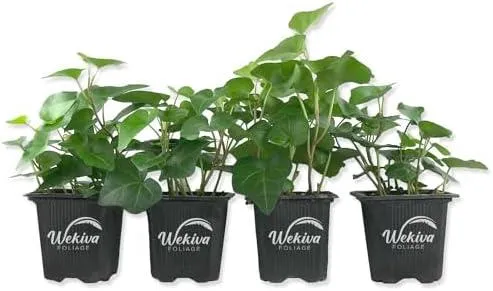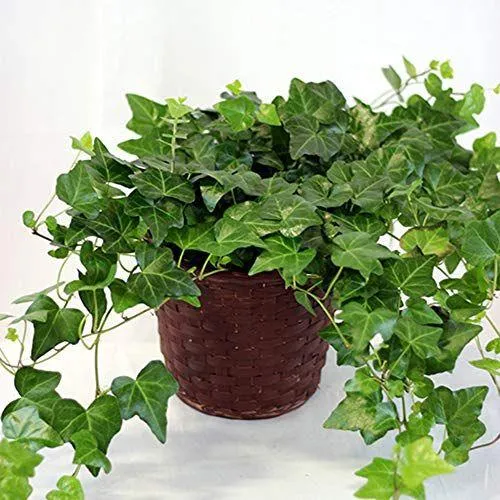
How to Propagate Ivy in Water for Gorgeous Houseplants
All You Need to Know About Propagating Ivy in Water
If you love the low-maintenance appeal of ivy creeping across walls and trees but don’t have the outdoor space for it, propagating ivy in water is a great option for growing it indoors. With just a few simple steps, you can multiply your ivy and begin filling your home with its lush green foliage. In this article, I’ll answer all the questions a gardener might have about propagating ivy in this easy method.
Why Propagate Ivy in Water?
Propagating ivy in water has several advantages over planting it directly in soil:
- It’s faster. Cuttings will root within 2-4 weeks in water, much quicker than sticking them directly into soil.
- Less room is needed. You don’t need potting soil or containers until the cuttings have developed roots. This allows you to get started with just a vessel of water.
- Less risk of shock. Putting freshly cut stems straight into soil without established roots can cause the cuttings to wilt or die. Water propagation lets them root gradually before planting.
- Great for indoor growing. Since it doesn’t require soil, water propagation lets you grow ivy on windowsills, desks, or any spot with bright light.
So if you’re looking to increase your ivy supply indoors without a lot of space or gardening know-how, propagating in water is a fantastic low-effort option.
Choosing Materials
All you need are a few basic items:

- Healthy ivy vines or stems with leaves – Cut stem sections that are 4-6 inches long.
- Clear glass or plastic container – A vase, jar, or cup works well. It should hold at least 1-2 inches of water.
- Distilled or purified water – Avoid tap water which may contain chemicals that inhibit rooting.
- Rooting hormone powder (optional) – This contains auxins that stimulate root growth, improving success rates.
Taking Cuttings
Now you’re ready to take cuttings and set them up for propagation:
- Use sterile pruners or scissors to trim stems from the parent ivy plant. Cut just below a leaf node (where leaves are attached).
- Remove all leaves from the bottom 1-2 inches of each stem to divert energy to root growth. Leave the top leaves intact to photosynthesize.
- If using rooting hormone, dip the bare stem ends in powder according to package instructions.
- Gently place stem cuttings upright in the water container, spacing them an inch or so apart. The bare stems should sit just below the waterline.
- Replace the water when it becomes cloudy to prevent root rot. Top up as needed to keep 1 inch of water.
- Place the container in bright, indirect light and wait 2-4 weeks for roots to form before potting up.
Maintaining Newly Rooted Cuttings
Once roots have emerged from the stem ends, it’s time to pot up your new ivy plants!
- Transplant carefully. Gently remove each rooted stem from water and tease away any loose roots.
- Use well-draining potting mix. Pot individually in 4-inch pots with a soilless mix or blended potting soil.
- Ease into light. Place in medium light and increase gradually over a week to harden off. Too much sun can burn new growth.
- Water periodically. Keep soil evenly moist but not soggy. Allow to partially dry between waterings as with mature ivy plants.
- Give nutrients once rooted. Fertilize lightly monthly in spring and summer with a dilute balanced houseplant food.
- Enjoy your propagated plants! They’ll grow fast and you can trim additional cuttings for more ivy.
Troubleshooting Rooting Problems
If roots fail to form or cuttings die off, common issues may include:
- Insufficient light – Ivy needs at least 4-6 hours of bright, indirect sun daily for proper rooting.
- Poor cutting technique – Be sure to remove bottom leaves and make clean cuts just under leaf nodes.
- Contaminated water – Change water regularly if it gets cloudy to prevent bacterial or fungal growth.
- Incorrect cutting maturity – Use new, flexible stems rather than stiff older wood which root less reliably.
- Lack of patience! – Roots may not form for 2-4 weeks, so don’t throw out cuttings too soon.
With the right conditions and materials, most healthy ivy cuttings should root successfully. If cuttings are healthy, don’t stress minor failures – you’ll gain experience with each new attempt!

Tips for Maximum Success
Here are some extra tips from my experience to maximize your rooting potential:
- Take cuttings on a cloudy day or in the morning when transplant shock is lower.
- Change water daily at first when cuttings are most vulnerable to rot.
- Add 1-2 drops of liquid rooting hormone to the water rather than dipping cuttings.
- Mist cuttings with a spray bottle to keep them from drying out.
- Keep a record of which varieties worked best so you know what to propagate more of!
- Share your extra rooted cuttings with plant-loving friends or a local garden club.
Well, with any luck those tips will help ensure your ivy cuttings root like crazy! Let me know if you have any other questions. Wishing you the best propagating – have fun watching your ivy multiply. Cheers!
Tips for Propagating Ivy in Water
| Type of Ivy | Time to Root | Care Tips |
|---|---|---|
| English Ivy | 2-4 weeks | Change water every 2-3 days. Keep cuttings in bright, indirect light. |
| Swedish Ivy | 3-6 weeks | Cut stems below a node. Place in shallow water and change weekly. Keep warm. |
| Needlepoint Ivy | 1-3 weeks | Use rooting hormone on stem ends. Change water every few days. Rotate for even growth. |
| Purple Heart | 2-4 weeks | Trim stem ends. Change water every 3-5 days. Roots better in bright indirect light. |
| Fig Ivy | 3-6 weeks | Use shallow container. Change water every 5-7 days. Place in warm spot with bright filtered light. |
FAQ
-
How can I grow ivy plants in water?
Basically, there are a few different ways to propagate ivy in water. You can take stem cuttings from an existing ivy plant, remove the bottom leaves, and place the stems directly into a glass of water. Make sure to change the water every few days. Another option is to take leaf cuttings – just place an ivy leaf with the stem still attached into a glass of water until roots form. Either way, once roots develop you can transplant the newly rooted cuttings into soil.
-
How long will it take for ivy cuttings to root in water?
It can take anywhere from a couple weeks to a month for ivy cuttings to put out roots in water, depending on factors like temperature and light levels. However, patience is key – don’t be too hasty in checking for roots. Perhaps the ivy cuttings just need more time. Give them at least 3-4 weeks before assuming they won’t root. Strong, established mother plants typically root faster than pieces from leggy, unwieldy vines.

-
What’s the best way to keep ivy cuttings healthy while rooting?
To help ivy cuttings thrive while rooting in water, make sure to position the glass in a warm, bright spot that gets indirect sunlight for several hours per day. Also, be sure to change the water every 3-5 days to prevent bacteria growth that could harm the cuttings. On the other hand, don’t overwater – only change it when the water looks dirty. Lastly, consider adding a few drops of liquid rooting hormone to the water, as some experts say this may boost rooting success.
-
Is it okay if the ivy cuttings wilt or drop leaves at first?
Yes, it’s quite normal for freshly taken ivy cuttings to wilt or drop some lower leaves when placed in water. The shock of being separated from the mother plant can cause temporary wilting or dropping. Don’t be alarmed by this – it’s a natural response. As long as you keep the water clean and maintain proper growing conditions, the cuttings will usually perk back up within a week or two as long as they are healthy to begin with. The true test is if new roots emerge over time.
-
When should I transplant rooted ivy cuttings to soil?
Usually, you can transplant ivy cuttings that have developed roots about 1/4 to 1/2 inch long into potting soil. This typically takes 2-4 weeks after being placed in water, depending on growing conditions. Make sure to gently remove any starter roots from the glass and transfer the entire cutting to a small pot. Place the newly potted cuttings in a warm, partially shaded spot and keep the soil consistently moist as they adjust to soil life. Soon your ivy propagation project will produce a lovely new potted plant!
-
What can go wrong with rooting ivy cuttings in water?
The main things that can cause ivy cuttings to fail when rooting in water are unattended proper care and less-than-ideal growing conditions. Dirty water, lack of light, cold temperatures – these can stress cuttings. Rotting can occur if stems sit in wet conditions too long. Pests like fungus gnats may attack weakened cuttings. By keeping water clean, warm, and bright, you maximize their chance of success. It also helps to use fresh, healthy parent ivy material to start. With some TLC and perhaps a dash of luck, your cuttings should be well on their way to becoming full plants.

-
What can I do with freshly rooted ivy plants?
Once ivy cuttings have developed roots in water and been transplanted to soil, they can be grown indoors as beautiful hanging baskets or tabletop plants that trail over the edges. Their lush vines look stunning draped on shelves, winding up poles, or trained onto wires or trellises to form living pictures. You can also plant several rooted cuttings together in larger pots for a fuller ivy effect. Try mingling ivy with other trailing plants too. Ultimately, propagated ivy opens up all sorts of decorative possibilities both indoors and out!